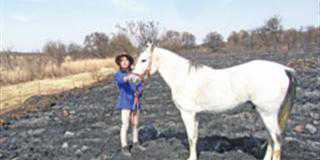
Photo: Kim Dyson
Even though many South Africans live in remote areas and access to a vet is a problem, some situations leave no room for an alternative. Nature can be cruel and injury and illness are a natural method of eliminating the old and weak to keep animal populations in check.
In the wild, the risk of injury and illness is a lot lower than in captivity, and we are sometimes guilty of causing some injuries. We expose our horses to a much higher risk of injury and illness by using tack and rugs, transporting them, fencing them in paddocks, feeding them contrived diets, and pushing them to their limits when we ride them.
Call the vet when there is:
- Heavy bleeding.
- Intense pain. Signs of this include groaning, violent rolling, eyes rolling, pawing at the ground, and straining.
- Sudden lameness or the unwillingness to move forward.
- Any foreign puncture wound or piece of wire protruding from the body.
- Difficult breathing.
- A yellowish fluid leaking from a joint.
- Any exposed bone.
Keep a close eye on your horse
Look out for the following signs and use your own discretion:
- Mild colic (usually this passes before the vet arrives).
- Diarrhoea or a loss of appetite.
- A wound that is not gushing blood, but might need flushing and stitches.
- Lameness but the horse is able to walk.
- Unusual behaviour, staggering or uncomfortable walking, abnormally aggressive or nervous behaviour.
- Lumps and bumps or an area that has a strange smell.
- Recurrent coughing or discharge from the nose.
Info for the vet
- Temperature? Take a thermometer and gently insert into the rectum, wait one minute and read the temperature. It is a good idea to take your horse’s temperature every morning to detect problems early.
- Check for shock: A symptom is poor circulation, which is evident in capillary refill time. This can be seen by pressing your thumb, or finger on your horses gum for two seconds. On release the ‘white’ area should turn pink within a second. General colour of gums and eyes (and vulva in a mare).
- Respiration: This is measured by counting how many times the rib cage lifts per minute.
- Pulse: This can be taken under the cheek bone or on the inside knee, or under the heart and counting the beats per minute. Your vet can handle any situation in which your horse finds itself. If your horse has a wound gushing bright blood, apply a pressure bandage. If this is not possible due to the area injured, take a piece of cloth saturated with staal druppels (essence available at your local pharmacy) or white sugar then place over the wound and apply firm pressure. If the wound is not severe, you can make a solution of 1 tablespoon salt to 1ℓ boiled water that has cooled. Rinse the wound with this solution and keep the area clean. The more often you rinse with clean water, the faster it will heal. Hygiene is the key to minimal scarring. Hypericum and calendula are wonderful herbs to speed up healing. Boiled water of organic peach leaves can be used as a rinse to speed up healing.













